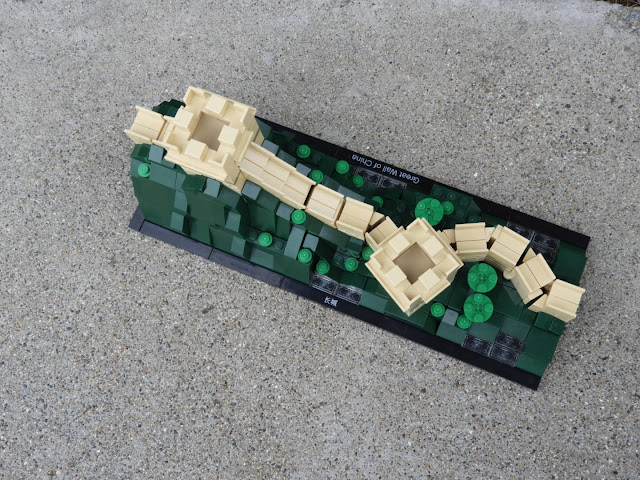 THE GREAT WALL OF CHINA (21041)
THE GREAT WALL OF CHINA (21041)by David Huynh
Huynh Architecture offers models suitable for display in the home and office and has been developed for all with an interest in travel, architectural culture, history, and design. Each set has a size, with true-to-life color depiction.
In addition, Huynh Architecture celebrates the world of architecture through the LEGO bricks.

“There in the mist, enormous,
majestic, silent and terrible,
stood the Great Wall of China.”
W. Somerset Maugham.
The Great Wall
For over 2000 years the Great Wall has wound its formidable way across the hills and mountains of the Chinese countryside. Its construction helped unify a new empire and strengthened the idea of China as a single nation. As an enduring symbol of China’s national pride, the wall remains one of the most impressive feats in the history of architecture.

Many people imagine the Great Wall to be one long uninterrupted structure. In reality it is more a 13,000 miles (21,000 km) network of walls that reflect the rise and fall of numerous kingdoms and dynasties. As such, the story of the Great Wall is also the story of China as the nation we recognize today.

In the 3rd Century B.C., Emperor Qin Shi Huang conquered his six neighboring kingdoms, establishing the Qin Dynasty and becoming the first Emperor of China. As well as linking together the many defensive walls the smaller kingdoms had built, he ordered the building of a new northern wall to protect his new empire from marauding tribes.

The following dynasties extended the wall further, but it was during the Ming Dynasty that much of the wall that we recognize today was constructed. In a period that stretched over 100 years, over 5,500 miles (8,850 km) of the wall was added. Unlike the first walls that had often been built using compacted earth or wood, these latest sections were made of carved stone or brick. Forts, flanking towers and ramparts were added to create a formidable defensive line.
The end of the Ming Dynasty in 1644 also signaled the end of any construction or maintenance of the Great Wall. This would continue until sections of the wall were restored and opened to the public by the government of the People’s Republic of China in the 1950s.
The Great Wall (Two Lego sets combine together) measures:
h (height) = 4.5 inches/ 114.3mm
l (length) = 21.4 inches/ 543.56mm
w(width) =4.5 inches/ 114.3mm
“A journey of a thousand miles
begins with a single step.”
Chinese proverb.

From then to now
It took several different Dynasties and over 2000 years to create the Great Wall we recognize today.
770 - 476 BC
The Spring & Autumn Period
Seven warring kingdoms built the first walls
to protect their borders.
221 - 206 BC
The Qin Dynasty
Qin Shi Huang becomes the first
Emperor of China and builds a
northern wall to defend his new
empire from Mongol harassment.
206 - 220 AD
The Han Dynasty
Extended the wall westward to protect the growing trade
travelling via the Silk Road.
618 - 907 AD
The Tang Dynasty
Was one of the most
prosperous and peaceful
dynasties in Chinese
history with little
construction to the wall.
960 - 1279 AD
The Song Dynasty
Enlarged and improved
the wall in an attempt
to stop invasion by the
 Manchus and Mongols.
Manchus and Mongols.1271 - 1368 AD
The Yuan Dynasty
The wall fails to stop the
Mongol invasion and China
comes under the control of
the Mongol Empire.
1368 - 1644 AD
The Ming Dynasty
The Chinese regain control
of the country and set about
systematically rebuilding and
strengthening the Great Wall.
1644 - Present
Post-Ming
The Manchus breach
the wall and end the last Chinese dynasty. The wall falls into disrepair.
“Until you reach the Great Wall,
you are no hero.”
Chairman Mao.
While foreign travelers have always marveled at the Great Wall, the Chinese themselves only started to appreciate the massive structure midway through the 20th century. This
was partly due to the historical financial and human costs of building the wall: heavy taxes had been imposed to pay for it and it’s estimated that hundreds of thousands of soldiers, laborers and convicts died during its construction. But also because it had failed to stop the invasions it was built to hinder.
Today the wall plays a major part in the Chinese national identity, and the restored sections, especially around Badaling, have become a major tourist destination with over 10 million visitors each year. The wall was made a UNESCO World Heritage Site in 1987, and has long been regarded as one of the seven modern wonders of the world.
“He who has never been to the
Great Wall is not a true man.”
Chinese poem.
Many myths and legends have emerged about the Great Wall. Unfortunately, the most famous one, that it is the only man-made structure on earth that can be seen with the naked eye from outer space, is untrue. At best, the wall can be spotted during a low orbit, but even then only if sunlight and weather permits it.
Glamorous view of the Great Wall was immersed in the collection

















Comments
Post a Comment